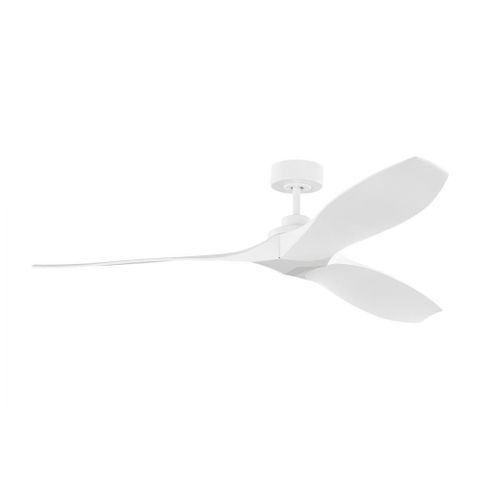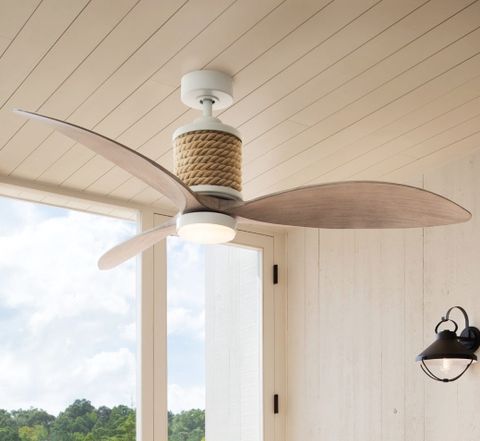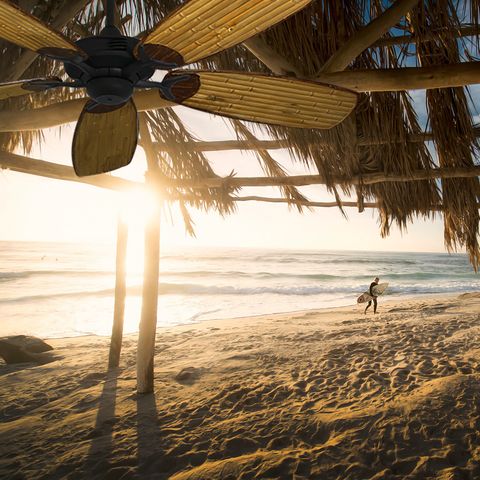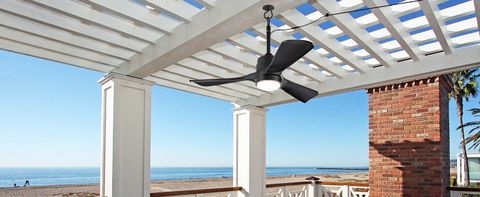Picture this: you’re relaxing on your coastal patio, the gentle breeze carries the scent of salt and seaweed, and you want to feel the cool air from a ceiling fan. But there’s a catch – you’re not just in any coastal area. You’re right by the ocean, where salt air, humidity, and weather extremes rule the day. What kind of fan do you choose? That’s exactly the question we’ll explore today.
Outdoor ceiling fans near the ocean present a unique set of challenges that most indoor fans simply aren’t built to handle. The combination of salt spray, high humidity, and constant exposure to the elements means that choosing the right materials isn’t just about aesthetics or cost – it’s about longevity and safety. Think about it: you’ve invested in a beautiful home with ocean views, and you want to enjoy that space year-round. A fan that fails after a few seasons because of corrosion or weather damage isn’t just frustrating – it’s expensive and inconvenient. Let’s dive into what really matters when selecting materials for these special situations.
The Salt Factor: Why It Matters More Than You Think
Salt spray is the main villain when it comes to outdoor fan durability. When ocean breezes carry salt particles through the air, they don’t just settle on surfaces – they penetrate and corrode metals over time. This happens faster than you might expect. The salt particles are incredibly fine and can travel much further than you’d imagine. Even if you’re not directly on the beachfront, the effects can be significant. A fan mounted just a few hundred feet from the water can experience the same corrosive effects as one right on the shore. The salt doesn’t discriminate between your fan blades and your patio furniture. It’s a slow but steady destroyer of metal components. This is why understanding how different materials react to salt is crucial. Some materials simply can’t handle the assault. Others have been specifically engineered to resist it. The difference can mean years of reliable service versus frequent replacements.
Metal vs. Non-Metal: The Great Debate
When you’re dealing with coastal environments, the choice between metal and non-metal components becomes critical. Aluminum is often seen as the gold standard for outdoor applications. It naturally resists corrosion better than steel, and when properly treated, it can last decades. Stainless steel is another solid option, particularly for structural components like mounting brackets. However, even stainless steel needs proper grade selection. Not all stainless steels are created equal, and some varieties are more susceptible to chloride-induced corrosion than others. On the non-metal side, materials like plastic and composite blends offer their own advantages. They don’t rust, but they can become brittle over time due to UV exposure and temperature fluctuations. Fiberglass is another popular choice, especially for blades. It’s lightweight, durable, and resistant to both moisture and UV damage. The key is finding the right balance between protection and performance. Sometimes you need to combine materials strategically – using aluminum for the motor housing and fiberglass for the blades, for instance.
Coating Technologies: The Shield Between Metal and Salt
Modern coating technologies have revolutionized outdoor fan durability. Powder coating, for example, creates a tough, protective layer that’s much more resistant to salt and moisture than traditional paint. It’s applied as a dry powder and then cured under heat, creating a uniform finish that’s extremely hard-wearing. Anodizing is another process that’s particularly effective for aluminum components. It creates a natural oxide layer that’s much more resistant to corrosion. Some manufacturers also use specialized marine-grade coatings that are specifically designed for harsh coastal environments. These coatings often include multiple layers and additives that enhance resistance to salt spray and UV degradation. The quality of the coating application matters enormously. A poorly applied coating can peel or chip within months, leaving the underlying metal exposed. Quality control during manufacturing ensures that these protective layers perform as intended over the long term.
Blade Design and Material Synergy
Blades are often the first components to show signs of wear in coastal conditions. The material choice for blades affects everything from airflow efficiency to maintenance requirements. Fiberglass blades are popular because they’re lightweight yet strong, and they don’t absorb moisture like wood or some plastics. They also tend to hold their shape better under varying temperatures. Plastic blades, while less expensive, can become brittle and crack over time, especially when exposed to UV light and temperature changes. Wood blades, though beautiful, require extensive maintenance and are generally not recommended for coastal installations. The design of the blade itself matters too. Curved blades typically provide better airflow than straight-blade designs, but they also catch more wind, which can increase stress on the motor. In salt environments, the blade’s surface area exposed to spray becomes particularly important. Some manufacturers use specialized blade profiles that direct water away from critical components. The material and design work together to maximize both performance and lifespan.
Environmental Considerations Beyond Salt Spray
While salt spray gets most of the attention, coastal environments present a whole range of challenges beyond just corrosion. High humidity levels accelerate the aging process for many materials, causing expansion and contraction cycles that can lead to cracking or loosening of components. UV radiation from the sun is particularly damaging to plastics and composites, breaking down molecular bonds and causing fading or brittleness. Wind loads also increase significantly near the ocean, where gusts can be stronger and more unpredictable than inland. Temperature swings between day and night, combined with the constant moisture, create a challenging environment for any outdoor equipment. Additionally, the salt can accumulate on surfaces and create a conductive layer that increases electrical risks. These factors all need to be considered when selecting materials, as no single component works in isolation. The entire system must be designed to withstand the cumulative effects of these environmental stresses.
Maintenance and Longevity: What to Expect
Even the best materials will eventually show signs of wear in a coastal environment. The key is understanding what to expect and planning accordingly. Regular cleaning with fresh water can help remove salt buildup before it causes damage. Most manufacturers recommend annual inspections to check for loose parts, worn coatings, or early signs of corrosion. Some materials may require periodic re-coating or treatment to maintain their protective properties. The investment in quality materials pays dividends in reduced maintenance costs over time. A fan that’s properly selected for coastal conditions will likely outlast several cheaper alternatives that seem appealing initially. It’s worth noting that the initial cost of a premium fan may be higher, but when you factor in replacement costs and ongoing maintenance, the savings can be substantial. Many coastal homeowners find that investing in a quality outdoor fan is one of the smartest decisions they make for their ocean-side property.
Choosing the right materials for outdoor ceiling fans near the ocean isn’t just about picking something that looks good. It’s about making informed decisions that will serve you well for years to come. The salt spray, humidity, and weather extremes demand materials that can stand up to constant assault. From aluminum and stainless steel to fiberglass and specialized coatings, each choice impacts the fan’s performance and lifespan. Remember that a fan’s success in a coastal environment depends not just on individual components, but on how all those parts work together. The investment you make in quality materials now will save you headaches later. So when you’re planning your next coastal upgrade, think about the long-term relationship you’re building with your outdoor fan. Choose wisely, and you’ll enjoy many more summers by the sea without worrying about whether your fan will survive the salt and sun.














